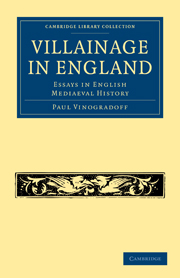Book contents
- Frontmatter
- PREFACE
- Contents
- INTRODUCTION
- FIRST ESSAY: THE PEASANTRY OF THE FEUDAL AGE
- SECOND ESSAY: THE MANOR AND THE VILLAGE COMMUNITY
- CHAPTER I THE OPEN FIELD SYSTEM AND THE HOLDINGS
- CHAPTER II RIGHTS OF COMMON
- CHAPTER III RURAL WORK AND RENTS
- CHAPTER IV THE LORD, HIS SERVANTS AND FREE TENANTS
- CHAPTER V THE MANORIAL COURTS
- CHAPTER VI THE MANOR AND THE VILLAGE COMMUNITY. CONCLUSIONS
- APPENDIX
- INDEX
CHAPTER I - THE OPEN FIELD SYSTEM AND THE HOLDINGS
Published online by Cambridge University Press: 16 May 2011
- Frontmatter
- PREFACE
- Contents
- INTRODUCTION
- FIRST ESSAY: THE PEASANTRY OF THE FEUDAL AGE
- SECOND ESSAY: THE MANOR AND THE VILLAGE COMMUNITY
- CHAPTER I THE OPEN FIELD SYSTEM AND THE HOLDINGS
- CHAPTER II RIGHTS OF COMMON
- CHAPTER III RURAL WORK AND RENTS
- CHAPTER IV THE LORD, HIS SERVANTS AND FREE TENANTS
- CHAPTER V THE MANORIAL COURTS
- CHAPTER VI THE MANOR AND THE VILLAGE COMMUNITY. CONCLUSIONS
- APPENDIX
- INDEX
Summary
Structure of the manor
My first essay has been devoted to the peasantry of feudal England in its social character. We have had to examine its classes or divisions in their relation to freedom, personal slavery, and praedial serfage. The land system was touched upon only so far as it influenced such classification, or was influenced by it.
But no correct estimate of the social standing of the peasantry can stop here, or content itself with legal or administrative definitions. In no degree of society do men stand isolated, and a description of individual status alone would be thoroughly incomplete. Men stand arranged in groups for economical and political cooperation, and these groups are composed according to the laws of the division and hierarchical organisation of labour, composed, that is, of heterogeneous elements, of members who have to fulfil different functions, and to occupy higher and lower positions. The normal group which forms as it were the constitutive cell of English mediaeval society is the manor, and we must try to make out in what way it was organised, and how it did its work in the thirteenth century, at the time of fully developed feudalism.
The structure of the ordinary manor is always the same. Under the headship of the lord we find two layers of population–the villains and the freeholders; and the territory occupied divides itself accordingly into demesne land and ‘tributary land’ (if I may use that phrase) of two different classes.
- Type
- Chapter
- Information
- Villainage in EnglandEssays in English Mediaeval History, pp. 223 - 258Publisher: Cambridge University PressPrint publication year: 2010First published in: 1892
- 1
- Cited by



